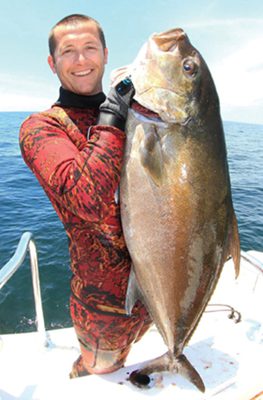
Almaco Jack, Seriola rivoliana
Florida State Record
35 pounds 8 ounces; caught in Destin Florida
International Game and Fish Association World Record
136 pounds; caught in Japan
Almaco jack belong to the Carangidae fish family, which includes jacks, runners, scads, jack mackerel and pompanos. The almaco is one of four species that could be referred to as “amberjack.” The other three species in the amberjack complex are the greater amberjack (Seriola dumerili), the lesser amberjack (Seriola fasciata) and the banded rudderfish (Seriola zonata). It can be difficult for anglers to properly identify the four species of amberjack. Tips and distinguishing characteristics can be found on our UF/IFAS blog page.
When speaking about amberjack, most anglers default to the greater amberjack, which in Florida are greatly targeted by the recreational and commercial fishing sectors because of their size, renowned fighting ability and food quality.
Pound for pound, the almaco jack have similar game qualities; however, they are seldom targeted and are often caught as bycatch. In Florida, encounters with 5- to 20- pound almaco jack are most common, but elsewhere in the world they get much larger.
In my opinion, these are the tastiest of the amberjack species with a more manageable fillet size that is easier to cook and is frequently used in sushi.
You can find Almaco jack all over the world in tropical and temperate seas.
Jacks are largely pelagic, utilizing the entire water column, but they visit the sea floor, where they occasionally feed on benthic fish and invertebrates. This species regularly is found in schools, and it inhabits rocky reef and wreck habitats from 15 to 800 feet deep.
It’s suggested that Almaco jack spawn between April and November in the southeastern United States and in the Caribbean. This species has buoyant eggs, and the early life history is most likely similar to its cousins, the greater amberjack, whose eggs hatch within 34 to 45 hours post fertilization.
Juvenile almacos have a strong association with sargassum algae utilizing the floating structure for shelter and feeding opportunities. A mature alamco jack is about 32 inches long and 4.5 years old. Almacos have been reported to live up to 22 years.
This species is currently being aquacultured in the United States in submerged net pens in Hawaii and is a great candidate for aquaculture in the Gulf of Mexico.
Almaco jack are a fast-growing species and in captivity have been known to reach weights of 4.4 pounds within the first year of life and 11 pounds in the second year. This is great news as almaco jack can be sustainably bred and grown, reducing pressure on wild stocks of fish while filling the demand for fresh, high-quality seafood.
— Michael Sipos is the Florida Sea Grant agent for UF/IFAS Extension. Contact him at sipos624@ufl.edu. For more fishy content and updates on upcoming educational programs, please check out the Sea Grant Facebook page, YouTube Channel, Instagram listing or Michael Sipos’ UF/IFAS blog.
